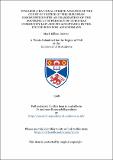Files in this item
Towards a rational choice analysis of the Court of Justice of the European Communities with an examination of the doctrine of supremacy of European Community law and its acceptance by the United Kingdom and Germany
Item metadata
| dc.contributor.advisor | Watson, Alison M. S. | |
| dc.contributor.author | Brewer, Mark Killian | |
| dc.coverage.spatial | 368 p. | en_US |
| dc.date.accessioned | 2018-07-10T11:03:27Z | |
| dc.date.available | 2018-07-10T11:03:27Z | |
| dc.date.issued | 1998 | |
| dc.identifier.uri | https://hdl.handle.net/10023/15170 | |
| dc.description.abstract | Despite an increasing awareness in the field of international relations of the importance of the Court of Justice of the European Communities in the process of European integration, few models have been devised to explain its role. Moreover, those models which have been formulated fail to withstand rigorous analysis. The current thesis examines several of the existing models, critiquing their respective weaknesses. Employing rational choice analysis, this research develops an alternative model, designated the architect's compromise model, to explain the role of the European Court of Justice (ECJ) in European integration and the acceptance of its judgements by the Member States. In addition to the general assumption that the Treaties of the European Communities do not form a constitution for the Communities, five assumptions form the foundation of the architect's compromise model. First, the key actors in the model are the ECJ and the Member States. Second, the actors are assumed to be rational, as defined as undertaking purposeful actions. Third, the ECJ is recognised as a strategic actor, employing a teleological approach to the Treaties of the European Communities. Fourth, the decisions of the ECJ usually conform to the long-term interests of the Member States as defined by the Treaties. Fifth, the Member States can be expected to abide by decisions of the European Court of Justice if its decisions conform to these long-term interests. To test these assumptions and the architect's compromise model of European integration, the thesis examines the doctrine of supremacy. After analysing supremacy in general, the thesis undertakes case studies on the acceptance of the doctrine of supremacy by the United Kingdom and Germany. Through the testing of the model, the research concludes that the architect's compromise offers an appropriate means of explaining the European Court's role in the process of European integration. | en_US |
| dc.language.iso | en | en_US |
| dc.publisher | University of St Andrews | |
| dc.subject.lcc | JN30.C7B8 | |
| dc.subject.lcsh | European Union | en |
| dc.title | Towards a rational choice analysis of the Court of Justice of the European Communities with an examination of the doctrine of supremacy of European Community law and its acceptance by the United Kingdom and Germany | en_US |
| dc.type | Thesis | en_US |
| dc.contributor.sponsor | University of St Andrews | en_US |
| dc.contributor.sponsor | Harry S. Truman Scholarship Foundation | en_US |
| dc.contributor.sponsor | UCL Overseas Research Scholarship (ORS) | en_US |
| dc.contributor.sponsor | Russell Trust | en_US |
| dc.type.qualificationlevel | Doctoral | en_US |
| dc.type.qualificationname | PhD Doctor of Philosophy | en_US |
| dc.publisher.institution | The University of St Andrews | en_US |
This item appears in the following Collection(s)
Items in the St Andrews Research Repository are protected by copyright, with all rights reserved, unless otherwise indicated.

